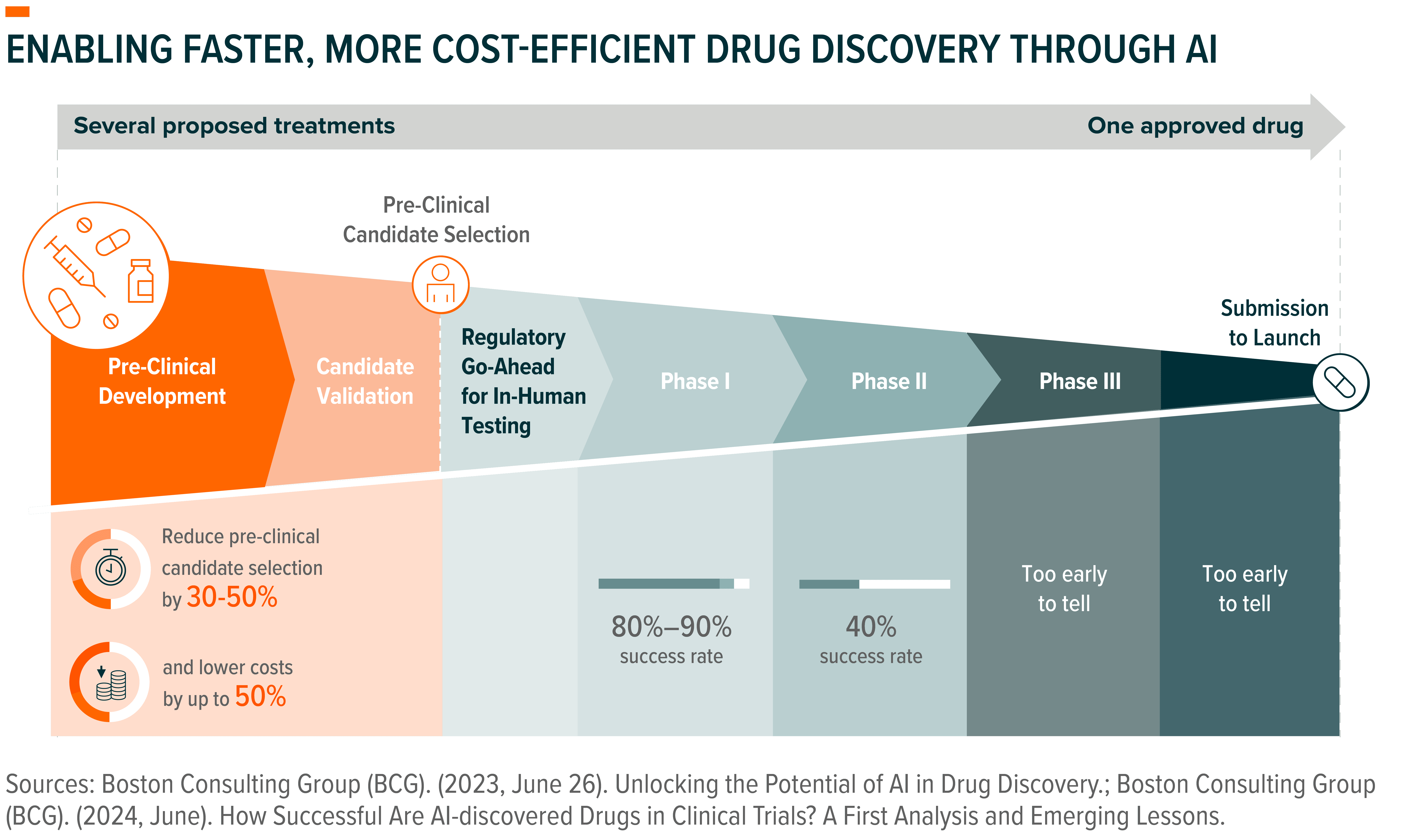
This piece is one in a series that delves further into the leading themes emerging from this year’s iteration of our flagship research project, Charting Disruption.
The healthcare industry faces a growing structural imbalance. As the population aged 65 and older expands nearly three times faster than younger cohorts, a global shortage of roughly 11 million healthcare workers is projected by 2030.1,2 Addressing this gap will require far more than incremental policy change – it will demand scalable, technology-driven solutions that enhance efficiency, reduce burnout, and allow clinicians to focus on patient care.
At the same time, technological innovation is accelerating across the healthcare ecosystem. Advances in data analytics, medical software, and smart devices are improving interoperability, usability, and privacy. Artificial intelligence (AI), in particular, is emerging as a connective force – linking data, diagnostics, and drug development into an increasingly integrated system. Together, these shifts are expanding the boundaries of what medicine can achieve, forming the foundation of a healthtech market expected to triple to $1.13 trillion by 2032.3
For investors, this convergence represents more than a technological evolution; it signals the rise of a scalable, data-driven model for global healthcare. The ability to identify where efficiency gains intersect with patient outcomes will define the next era of innovation-led growth in the sector.

Key Takeaways
- The healthtech industry is on track to triple from $352 billion in 2025 to over $1.1 trillion by 2032, driven by critical needs in provider capacity, aging populations, and chronic disease management.4
- Artificial intelligence is modernizing healthcare delivery, reducing administrative burdens, accelerating drug discovery, and enabling systems that can learn and improve at scale.
- AI-enabled medical devices – from surgical robots to wearable sensors – are expanding precision and access, transforming both clinical practice and home-based care while driving efficiency across the healthcare ecosystem.
Artificial Intelligence and the Digital Transformation of Healthcare
While healthcare innovation has advanced rapidly in areas such as genomics and robotic surgery, many administrative workflows remain stubbornly analog. Nearly 80% of U.S. medical documentation still relies on fax or traditional mail, underscoring a widening gap between clinical advancement and operational efficiency.5 Existing systems often fail to help the industry scale, instead becoming bottlenecks that contribute to physician burnout. Doctors can spend up to 39% of their time documenting patient information in legacy electronic medical records (EMRs).6
Artificial intelligence is poised to change that dynamic, ushering in the next generation of healthcare software focused on usability, automation, and effectiveness over administrative burden. New solutions could recover more than 30% of physician time while meaningfully reducing burnout.7 As these technologies proliferate, up to 17% of staff tasks could be fully automated – allowing clinicians to redirect their time toward patient care.8
Greater digitalization and advanced analytics, in turn, enable healthcare systems to learn at scale. As data becomes more connected and interpretable, every diagnosis, treatment, and outcome can feed into a continuously improving model of care – advancing medicine not one patient at a time, but for everyone at once. Scalable learning represents the next inflection point in healthcare’s evolution, transforming disconnected records into shared intelligence. With AI accelerating that shift, medicine can move from reactive to predictive – improving efficiency, outcomes, and the long-term sustainability of the healthcare system.
AI and the Next Generation of Drug Development
Artificial intelligence could fundamentally reshape the future of drug development. Bringing a new medicine to market still takes 10-15 years and costs an average of $1.6 billion, with only one in ten investigational drugs ultimately succeeding.9,10,11 By running millions of simulations, AI models can reduce preclinical development costs by 30–50% and help make drug design and validation 15 times faster.12,13
For pharmaceutical companies, these advances go beyond efficiency. AI enhances decision-making across the R&D process – from patient recruitment and trial design to predictive modeling, candidate selection, and diagnostics – ultimately improving success rates and personalizing treatments. An estimated 95% of pharmaceutical firms are already investing in AI, reflecting its growing role in reducing costs, compressing timelines, and improving outcomes.14
Drug discovery software is expected to be the fastest-growing generative AI segment, expanding from virtually zero in 2024 to an estimated $41 billion market.15 By improving efficiency and scalability, these tools could reshape the economics of R&D – allowing firms to pursue more drug candidates with greater precision and lower risk. Traditional technology players also stand to gain, with companies like Nvidia already generating over $1 billion in annual healthcare revenue.16

Conclusion: The Future of Scalable, Intelligent Healthcare
HealthTech is redefining how care is delivered, scaled, and sustained. Artificial intelligence is helping to close long-standing gaps between demand and capacity, enabling clinicians to focus on patients rather than paperwork, while generative models accelerate drug development and lower R&D costs. Beyond software, advances in surgical robotics and wearable sensors are extending the reach of technology from the operating room to the individual — improving precision, expanding access, and creating continuous feedback loops between treatment and data.
Together, these innovations are transforming healthcare from a system constrained by inefficiency into one powered by intelligence. As these technologies converge, we expect them to not only improve patient outcomes, but also support the development of a more scalable and resilient model for global healthcare – representing a potentially durable, long-term opportunity for thematic investors.
For additional insights, please view our full report, Charting Disruption: Outlook for 2026 and Beyond.
